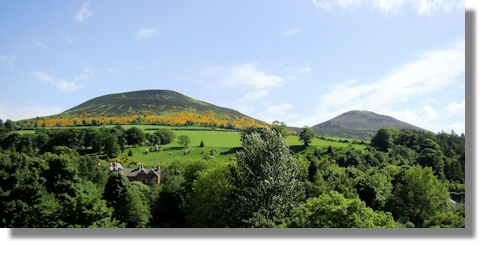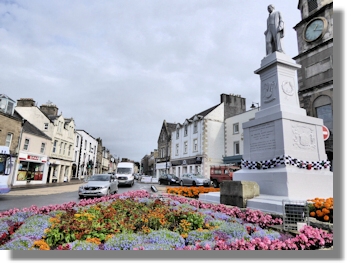 A Tour of the Scottish Borders
A Tour of the Scottish Borders
 A Tour of the Scottish Borders
A Tour of the Scottish Borders

"Yet was poetic impulse given
By green hill and clear blue heaven"
Sir Walter Scott"The Scottish Borders looks more Scottish in appearance and atmosphere - it is what people think the Highlands look and feel like".
Billy Connolly, World Tour of Scotland.Introduction
The Border country of Scotland has been described as a conundrum - an extraordinary complex and colourful blend of breathtaking, gentle, green landscape, a dramatic sense of history, grand aristocratic mansions, castle ruins, a rich literary heritage and also an adventure playground of outdoor sports and leisure activities. Although just an hour or so south of Glasgow and Edinburgh, it's often an area ignored and forgotten by visitors and by those who live here.There's a great deal going on to see and do, whatever your interests, across the vast expanse of 1800 square miles stretching from the ancient fishing villages of Berwickshire on the east coast to the farmlands of Dumfries and Galloway in the west, the Lothians to the north and the English border to the south. The Scottish Borders is one of 32 council areas of Scotland and it borders the City of Edinburgh, Dumfries and Galloway, East Lothian, Midlothian, South Lanarkshire, West Lothian and, to the south and east, Cumbria and Northumberland in England.
Tourism is a major industry in the area and the new rail service from Edinburgh to Tweedbank (near Galashiels) means that Edinburgh is now 55 minutes away by train.
A Brief History
The Romans arrived in the Tweed valley in 79AD and under Agricola's army they built several defense forts as part of a major military settlement. They came but could not conquer, with one Roman commentator declaring that the Britons could not be kept under Roman control and described this northern region as 'Britannica Barbarica', peopled by hostile tribes. News of rebellion brought the new emperor Hadrian to visit Britain in 122AD and he decided that a great wall should be erected running more than 70 miles from the mouth of the River Tyne across to Carlisle and down to the Cumbrian coastline. While not recognised as a political frontier as such, Hadrian's wall inadvertently began the notion of distinct north and south regions of Britain, and many centuries later, the creation of Alba, the separate nation of Scotland. The creation of a Border and the Border country therefore is a man-made invention. The people were closely linked through landscape, sheep farming, history and culture to Northumbria to the south and up until the 9th century, especially during the reign of David I, this region of Mid Britain flourished and prospered.
This was a period of medieval renaissance when great monasteries and abbeys were built in Kelso, Jedburgh, Melrose and Dryburgh. The wealthy wool traders preferred to export from Berwick direct to Europe rather than to their southern neighbours. Writers, scholars and intellectuals too travelled to share and exchange ideas and culture across France and Italy. The golden age was however shortlived following the death of Alexander III in 1286. The wars of independence between England and Scotland began, not least the endlessly disputed battle of the Border territory involving brutal warfare and devastation. A civil war of a kind broke out as law and order broke down; the Border Reivers began to criss-cross the rich farmlands between the Cheviots and Lammermuir hills and the Yorkshire dales, plotting and plundering everything they could seize. The English and the Scots, previously close and friendly neighbours, stole cattle, sheep and horses from each other. They were similar to the Rustlers of the American Wild West, riding in troops, hiding and lurking in the darkness of night and thick mists of the valleys.
This vicious and destructive period raged for centuries, provoked by the continuous contention between the Kings of England and Scotland, contesting the border frontier. Local commerce and international trade withered as the image of the Border region became one of danger, notoriety and lawlessness. One town at the centre of the dispute was Berwick, situated in the vitally important vanguard position at the mouth of the Tweed, which between the 12th and 15th centuries changed hands between England and Scotland thirteen times. There were sieges and destruction with the citizens forced to flee or be killed. Today Berwick is just south of the Border but very Scottish in character and interests. The football team plays for the Scottish league.These were cruel and brutal times and in utter contrast to the peaceful and prosperous times beforehand when the ancient counties of Mid-Britain lived harmoniously side by side. Quite simply, the building of Hadrian's Wall was not a good thing for the Borders.
The Scottish Borders Today

The people of the Borders region today retain a strong-willed independence and distinctive character borne out of the determination to preserve their lands. The 300-year feud when the Borders region was caught in the turmoil between England and Scotland could have destroyed more than just the magnificent abbeys and pride of face. The Borders people held on tenaciously to a sense of identity and culture throughout the troubles and beyond. Local poets and writers used their daily encounters and experiences to write stories and ballads inspired by every aspect of Borders life, from the shepherds, supernatural folklore, love and romance to the plundering and pillage by the Reivers. Oral history was, and is, very strong and strolling minstrels spread the word by singing these heartfelt ballads wherever they travelled.The graphic on the left is the centre of Selkirk with a statue of Sir Walter Scott standing in front of a building which was a court house in his day (and is now a museum).
"Last night a wind from Lammermuir came roaring up the glen,
With the tramp of trooping horses and the laugh of reckless men,
And struck a mailed hand on the gate and cried in rebel glee,
Come forth, come forth my Borderer, and ride the March with me."
William Ogilvie, from "The Raiders."The story of the Borders` people and their fight for survival has always been at the heart of their strong literary heritage. The Border Ballads inspired two great writers, James Hogg and Sir Walter Scott. And it's through Scott's epic novels and poetry as well as his own passionate love-affair with the Tweed valley which put the Borders firmly on the map - then and now - as a beautiful and romantic place to visit.
Next page The Borders Towns > Page 1, 2, 3.
Or return to Index of Places to Visit
Where else would you like to go in Scotland?

